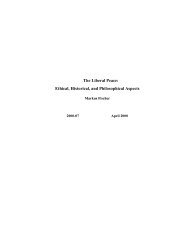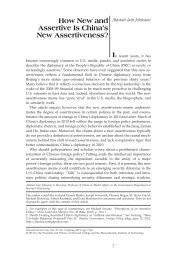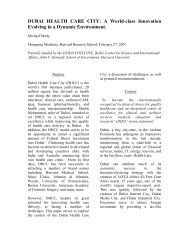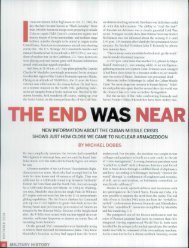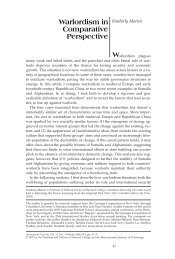The Promise and Problems of Pricing Carbon: - Belfer Center for ...
The Promise and Problems of Pricing Carbon: - Belfer Center for ...
The Promise and Problems of Pricing Carbon: - Belfer Center for ...
You also want an ePaper? Increase the reach of your titles
YUMPU automatically turns print PDFs into web optimized ePapers that Google loves.
THE PROMISE AND PROBLEMS OF PRICING CARBON BELFER CENTER 2011-12<br />
Decentralized, Bottom-Up Architectures<br />
Cap-<strong>and</strong>-trade systems seem to have emerged as the preferred national <strong>and</strong> regional<br />
instrument <strong>for</strong> reducing emissions <strong>of</strong> greenhouse gases throughout much <strong>of</strong> the industrialized<br />
world, <strong>and</strong> the CDM has developed a substantial constituency, despite concerns about its<br />
per<strong>for</strong>mance. Because linkage between tradable permit systems (that is, unilateral or bilateral<br />
recognition <strong>of</strong> allowances from one system <strong>for</strong> use in another) can reduce compliance costs <strong>and</strong><br />
improve market liquidity, there is great interest in linking cap-<strong>and</strong>-trade systems with each other.<br />
<strong>The</strong>re are not only benefits but also concerns associated with various types <strong>of</strong> linkages<br />
(Jaffe, Ranson, <strong>and</strong> Stavins, 2010). A major concern is that when two cap-<strong>and</strong>-trade systems are<br />
directly linked (that is, allow bilateral recognition <strong>of</strong> allowances in the two jurisdictions), key<br />
cost-containment mechanisms, such as safety-valves, are automatically propagated from one<br />
system to the other. Because some jurisdictions (such as the European Union) are opposed to the<br />
notion <strong>of</strong> a safety valve, whereas other jurisdictions (such as the United States) seem very<br />
favorably predisposed to the use <strong>of</strong> a safety valve, challenging harmonization would be required.<br />
This problem can be avoided by the use <strong>of</strong> indirect linkage, whereby two cap-<strong>and</strong>-trade<br />
systems accept <strong>of</strong>fsets from a common emission-reduction-credit system, such as the Clean<br />
Development Mechanism. As a result, the allowance prices <strong>of</strong> the two cap-<strong>and</strong>-trade systems<br />
converge (as long as the ERC market is sufficiently deep), <strong>and</strong> all the benefits <strong>of</strong> direct linkage<br />
are achieved (lower aggregate cost, reduced market power, decreased price volatility), but<br />
without the propagation from one system to another <strong>of</strong> cost-containment mechanisms. Such<br />
indirect linkage may already be evolving as a key element <strong>of</strong> the de facto post-2012 international<br />
climate policy architecture.<br />
Despite the apparent current popularity <strong>of</strong> cap-<strong>and</strong>-trade as a national policy approach in<br />
many parts <strong>of</strong> the world, in reality, there are a variety <strong>of</strong> policy instruments – both market-based<br />
<strong>and</strong> conventional comm<strong>and</strong>-<strong>and</strong>-control – that countries can employ to reduce their GHG<br />
emissions. Hence, it is important to ask whether a diverse set <strong>of</strong> heterogeneous national, subnational,<br />
or regional climate policy instruments can be linked in productive ways. <strong>The</strong> basic<br />
answer is that such a set <strong>of</strong> instruments can be linked, but the linkage is considerably more<br />
difficult than it is with a set <strong>of</strong> more homogeneous tradable permit systems (Hahn <strong>and</strong> Stavins,<br />
1999). In fact, the basic approach behind emission reduction credit systems such as the CDM<br />
<strong>and</strong> Joint Implementation (JI) can be extended to foster linkage opportunities among diverse<br />
26





